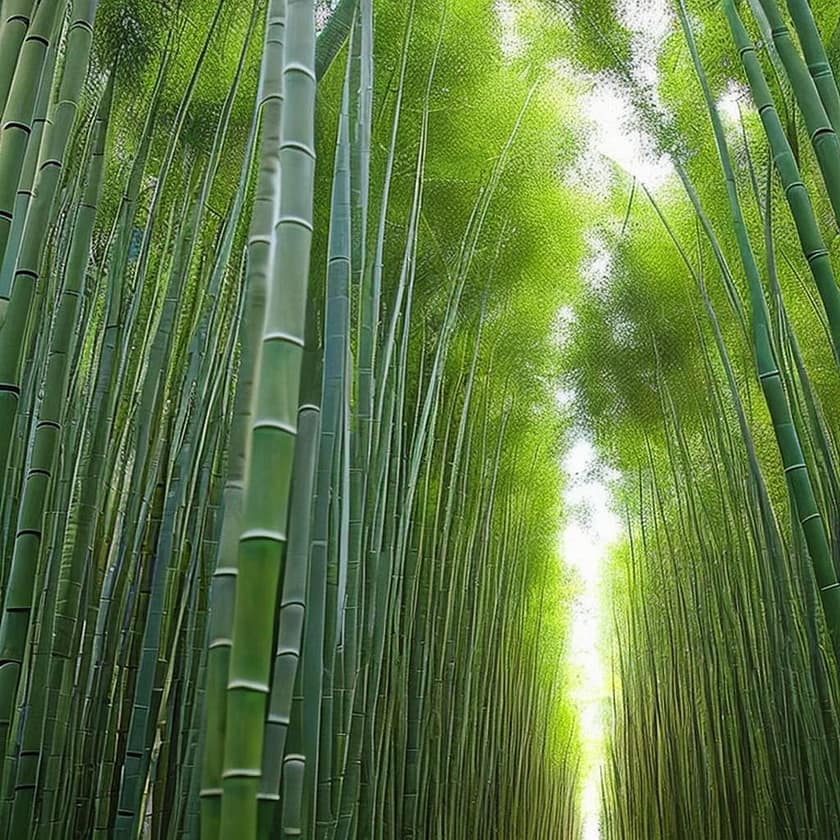How to research your type of bamboo
To research the type of bamboo you have, you can follow these steps:
Identify the species
There are over 1,600 species of bamboo, so the first step is to identify the species of bamboo you have. You can do this by examining the leaves, stems, and growth habit of the plant, or by consulting a field guide or botanical reference book.
Research the characteristics
Once you have identified the species, you can research its specific characteristics, such as its growth habit, size, and cultural requirements. You can find this information in books, online resources, or by consulting a local horticulturist or bamboo expert.
Determine its uses
Depending on the species, bamboo can have a wide range of uses, such as food, fiber, construction material, or ornamental plant. You can research the traditional uses of bamboo in the culture or region where the plant is native, or explore the modern uses of bamboo in various industries.
Consider its toxicity
Some species of bamboo contain toxic compounds that need to be removed before the shoots or leaves can be eaten. You can research the toxicity of your species and learn how to properly prepare and cook the edible parts.
Learn how to care for it
Finally, you can research the specific care requirements for your species of bamboo, such as soil type, watering needs, and pruning techniques. This will help you ensure that your plant stays healthy and thrives in its environment.
Researching your type of bamboo can help you understand its unique characteristics and uses, as well as how to care for it properly.
A classification for the species, their characteristics and toxiticy
Here are some common species of bamboo, along with their characteristics and toxicity information:
Moso bamboo (Phyllostachys edulis)
This species is one of the largest and most popular types of bamboo, with tall, straight stems and large leaves. Moso bamboo is used for a variety of purposes, including construction, paper-making, and as a food source. The shoots are edible but must be boiled or otherwise processed to remove toxins.
Giant bamboo (Dendrocalamus giganteus)
As the name suggests, this species is known for its enormous size, with stems that can grow up to 30 meters (100 feet) tall. Giant bamboo is used primarily for construction and furniture-making, and its shoots are edible but must be boiled or soaked to remove toxins.
Black bamboo (Phyllostachys nigra)
This species is prized for its attractive black stems, which turn green with age. Black bamboo is often used in landscaping and as an ornamental plant, but it is not typically used for food or construction. The shoots are edible but must be boiled or otherwise processed to remove toxins.
Golden bamboo (Phyllostachys aurea)
This species is known for its vibrant golden-yellow stems and is often used in landscaping and as a privacy screen. The shoots are edible but must be boiled or soaked to remove toxins.
Heavenly bamboo (Nandina domestica)
Despite its name, this plant is not actually a bamboo, but rather a member of the barberry family. It is grown for its attractive foliage and red berries, but all parts of the plant, including the berries, are toxic if ingested.
Arrow bamboo (Pseudosasa japonica)
This species is known for its straight stems, which were traditionally used to make arrows. Arrow bamboo is also used for construction and as an ornamental plant, and its shoots are edible but must be boiled or soaked to remove toxins.
Timor black bamboo (Gigantochloa atroviolacea)
This species is known for its dark purple-black stems, which are highly sought after for their ornamental value. Timor black bamboo is also used for construction, furniture-making, and as a food source. The shoots are edible but must be boiled or soaked to remove toxins.
Buddha belly bamboo (Bambusa ventricosa)
This species is named for its distinctive bulbous nodes, which give the stems a unique appearance. Buddha belly bamboo is often grown as an ornamental plant, but it can also be used for construction and furniture-making. The shoots are edible but must be boiled or soaked to remove toxins.
Thorny bamboo (Bambusa arundinacea)
This species is known for its thorny stems and is often used as a barrier plant or to deter animals from entering a garden. Thorny bamboo is also used for construction, furniture-making, and as a food source. The shoots are edible but must be boiled or soaked to remove toxins.
Dragon bamboo (Fargesia dracocephala)
This species is a smaller type of bamboo that is often grown as an ornamental plant. Dragon bamboo is known for its cold hardiness and ability to grow in shaded areas. The shoots are edible but must be boiled or soaked to remove toxins.
Yellow-groove bamboo (Phyllostachys aureosulcata)
This species is known for its yellow-grooved stems and is often grown as an ornamental plant or for erosion control. Yellow-groove bamboo is also used for construction and furniture-making, and its shoots are edible but must be boiled or soaked to remove toxins.
It’s important to note that the toxicity of bamboo shoots can vary depending on the species and how they are prepared. Some species contain cyanogenic glycosides, which can release hydrogen cyanide when consumed raw or undercooked. If you plan to consume bamboo shoots, it’s important to research the specific species you have and learn how to properly prepare and cook them to avoid any potential health risks.
Most common species grown in Europe
Bamboo is not native to Europe, but there are several species that can be grown in European climates with proper care. Some of the most common species of bamboo grown in Europe include:
Phyllostachys aurea (Golden bamboo):
This species is native to China but can be grown in many parts of Europe. It is known for its bright golden-yellow stems and is often grown as an ornamental plant or for privacy screening.
Phyllostachys nigra (Black bamboo)
This species is native to China and is known for its striking black stems that turn green over time. Black bamboo is often grown as an ornamental plant or for use in landscaping.
Phyllostachys vivax (Giant bamboo)
This species is native to China and can grow up to 20 meters (65 feet) tall in ideal conditions. Giant bamboo is often grown for construction or as an ornamental plant in larger gardens.
Fargesia murielae (Umbrella bamboo)
This species is native to China and is known for its compact, clumping growth habit and small, delicate leaves. Umbrella bamboo is often grown as an ornamental plant or for use in small gardens and containers.
Pleioblastus pygmaeus (Dwarf bamboo)
This species is native to Japan and is known for its small, compact size and tolerance of cold temperatures. Dwarf bamboo is often grown as an ornamental plant or for use in small gardens and containers.
Not all species of bamboo are suitable for all European climates, so it’s important to research the specific needs and requirements of each species before growing them.
Table summarizing the species of bamboo we have discussed, along with their characteristics and toxicity information
| Species | Characteristics | Toxicity Information |
| Phyllostachys edulis | Tall, straight stems and large leaves; used for construction, paper-making, and food | Shoots are edible but must be boiled or otherwise processed to remove toxins |
| Dendrocalamus giganteus | Enormous size with stems up to 30 meters (100 feet) tall; used for construction and furniture-making | Shoots are edible but must be boiled or soaked to remove toxins |
| Phyllostachys nigra | Attractive black stems that turn green with age; used in landscaping and as an ornamental plant | Shoots are edible but must be boiled or otherwise processed to remove toxins |
| Phyllostachys aurea | Vibrant golden-yellow stems; used in landscaping and as a privacy screen | Shoots are edible but must be boiled or soaked to remove toxins |
| Nandina domestica | Not actually a bamboo, but grown for its attractive foliage and red berries; toxic if ingested | All parts of the plant, including the berries, are toxic if ingested |
| Pseudosasa japonica | Known for its straight stems, which were traditionally used to make arrows; used for construction and as an ornamental plant | Shoots are edible but must be boiled or soaked to remove toxins |
| Gigantochloa atroviolacea | Dark purple-black stems; used for construction, furniture-making, and as a food source | Shoots are edible but must be boiled or soaked to remove toxins |
| Bambusa ventricosa | Distinctive bulbous nodes; often grown as an ornamental plant, but used for construction and furniture-making | Shoots are edible but must be boiled or soaked to remove toxins |
| Bambusa arundinacea | Known for its thorny stems; used as a barrier plant or to deter animals; also used for construction, furniture-making, and as a food source | Shoots are edible but must be boiled or soaked to remove toxins |
| Fargesia dracocephala | Smaller type of bamboo often grown as an ornamental plant; known for cold hardiness and ability to grow in shaded areas | Shoots are edible but must be boiled or soaked to remove toxins |
| Phyllostachys aureosulcata | Known for its yellow-grooved stems; often grown as an ornamental plant or for erosion control; used for construction and furniture-making | Shoots are edible but must be boiled or soaked to remove toxins |
The toxicity of bamboo shoots can vary depending on the species and how they are prepared, so it’s essential to research the specific species you have and learn how to properly prepare and cook the edible parts.

Thank you for likes, shares and comments! 🌳🌴🌲🌵
Source OpenAI’s chatGPT Language Models, Dalle, AI trot and Fleeky
images Picsart and MIB
Invest in your future
Take time to learn
Embark on your journey in affiliate marketing and website creation alongside an incredible community and myself. Invest in your future by dedicating time to learn and earn. Take all the time you need to master the basics before aiming higher. Give it a try and sign up for free. You won't regret it! Discover the possibilities for yourself...


